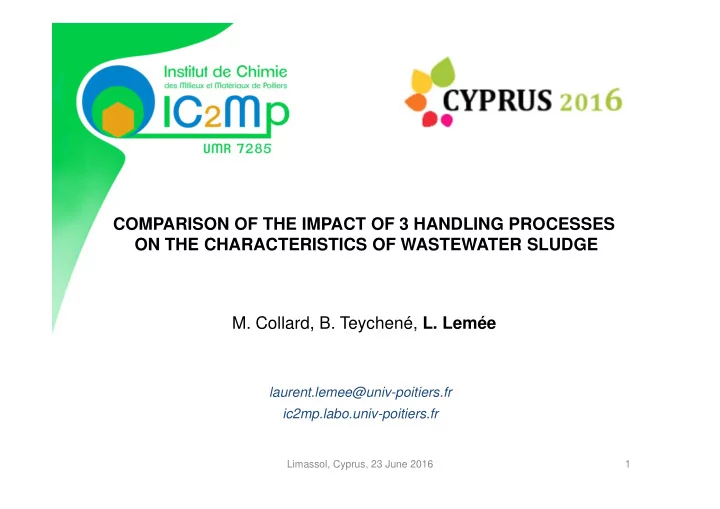

COMPARISON OF THE IMPACT OF 3 HANDLING PROCESSES ON THE CHARACTERISTICS OF WASTEWATER SLUDGE M. Collard, B. Teychené, L. Lemée laurent.lemee@univ-poitiers.fr ic2mp.labo.univ-poitiers.fr Limassol, Cyprus, 23 June 2016 1
Wastewater treatment generates sludge (13 Mt dry sludge expected by 2020) But could also be considered as an unlimited resource for • Water via re-use, • Energy (methane), • Phosphorous, • Fertilizer Limassol, Cyprus, 23 June 2016 2
Landfarming main solution for sludge management (72%), - sustainable contrarily to incineration or landfill - accelerates the restoration of soils - reverse global warming (4% 0 initiative) Limassol, Cyprus, 23 June 2016 3
Handling process Implemented prior to land farming, aims at • Reducing the volume thus transportation cost • producing energy • Sanitizing (stabilizing) • Improving agronomic properties • Degrading contaminants Limassol, Cyprus, 23 June 2016 4
Objective Evaluate the impact of processes on sludge characteristics, to envisage the environmental fate of this organic matter Compared dried, irradiated and digested sludge at the global and molecular scale Limassol, Cyprus, 23 June 2016 5
Wastewater treatment plant of Poitiers (France) Limassol, Cyprus, 23 June 2016 6
Floated sludge Digestion e-beam irradiation Thermal drying real scale pilot Laboratory-scale digester treatment plant AOP : HO • and e - aq • Dried sludge 85 ° C • 1 kGy (sanitisation dose) • Pellets 120 ° C • 50 kGy 3L sludge 4 weeks Limassol, Cyprus, 23 June 2016 7
Infrared Spectroscopy C=O O-H , N-H C-H C=C δ C-O I C-O/C-H 0,17 0,15 0,13 0,11 Increase for e-beam oxydation of OM 0,09 0,07 0,05 0 1 50 kGy Limassol, Cyprus, 23 June 2016 8
Chemical fractionation sludge CH 2 Cl 2 /MeOH Lipids organo-soluble residue HCl NaOH « Humin » « fulvic Acids» acido-soluble « humic Acids » alcalino-soluble Limassol, Cyprus, 23 June 2016 9
Impact of treatments at the global level Lipids Fulvic acids Humic acids Humin ash 100 e-beam thermal Digestion 80 60 40 20 0 Floated dried pellets 1 kGy 50 kGy 1 w 2 w 3 w 4 w sludge 85°C 120°C Decrease in OM Weakening Changes in soluble and particularly lipids at 120 ° C fractions Limassol, Cyprus, 23 June 2016 10
Thermal analysis WL exo1/exo2 1 temperature difference(C/mg) 0,90 0,85 Weight loss (%) 0,80 2 0,75 0,70 0,65 0,60 0,55 0,50 FS 85 120 Thermal drying Temperature DSC : 2 exotherms 1 : desorption of volatiles (350 ° C) • 2 : oxidation of heavy weight compounds (500 ° C) • TGA : Weight loss associated with exo1/exo2 increases with weakening of OM Limassol, Cyprus, 23 June 2016 11
Double-shot pyrolysis Pyrolysis = use of thermal energy only to break chemical bonds 1. low temperature : desorption of volatile molecules 2. Higher temperature : breaks covalent bonds of high Mw compounds analyser ionisation MS GC Information at the molecular scale Limassol, Cyprus, 23 June 2016 12
First-shot 350° C DSC Fatty acids Steroïds 120 0,6 0,5 100 0,4 80 0,3 60 0,2 40 0,1 20 0 0 ‐ 0,1 0 200 400 600 800 1000 Tem perature ( ° C) Thermal drying 120 ° Limassol, Cyprus, 23 June 2016 13
Second-shot 600° C DSC 120 0,6 Tem perature difference( ° C/ m g) 0,5 100 0,4 80 0,3 60 0,2 40 0,1 20 0 0 ‐ 0,1 0 200 400 600 800 1000 Tem perature ( ° C) Thermal drying 120 ° Aromatic monomers from refractory biopolymers (liginin, proteins, chitin,…) Limassol, Cyprus, 23 June 2016 14
Double-shot pyrolysis thermal e-beam Digestion 60 mg/g OM FaMe Sterols aromatics 50 40 30 20 10 0 floated dried pellets 1 kGy 50 kGy 1 w 2 w 3 w 4 w sludge 85°C 120°C • Visible changes at the molecular level for FaMe and sterols Limassol, Cyprus, 23 June 2016 15
First-shot 350 ° C : fatty acids C 15 i C 16 a n C 17 C 18 i a n Branched (i+a)/linear , plant , , , Ion extract (m/z 74) , floated 85 120 • Decrease with thermal drying • Stable after 2w digestion Bacterial origin Limassol, Cyprus, 23 June 2016 16
First-shot 350 ° C : s teroids Stanols Sterols coprostanol cholesterol R stanols/sterols Ion extract(m/z 213,215) , , , , , , Increase with thermal drying , , , 85 ° C 120 ° C floated Limassol, Cyprus, 23 June 2016 17
Conclusion • Elemental analysis, Infrared spectroscopy : decrease in OM content with 1kGy and digestion oxidation with e-beam • Chemical fractionation, thermal analysis : Weakening with thermal drying and 50 kGy Complexification with 1 kGy • Py-GC/MS : information at the molecular scale Changes in fatty acids and steroids Degradation of aromatics with e-beam only Limassol, Cyprus, 23 June 2016 18
Thanks for your attention Limassol, Cyprus, 23 June 2016 19
Recommend
More recommend